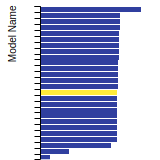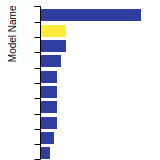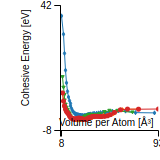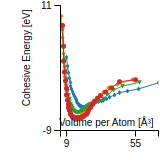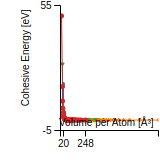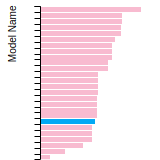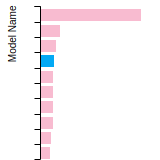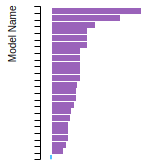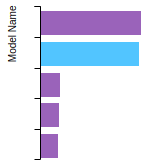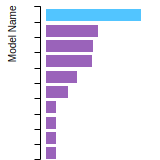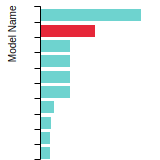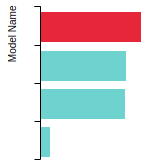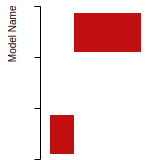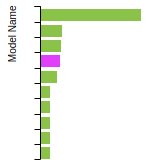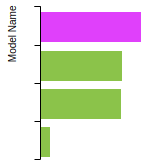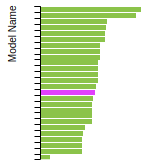 EAM_Dynamo_SmirnovaKuskinStarikov_2013_UMoXe__MO_679329885632_005
EAM_Dynamo_SmirnovaKuskinStarikov_2013_UMoXe__MO_679329885632_005
| Title
A single sentence description.
|
EAM potential (LAMMPS cubic hermite tabulation) for the ternary U-Mo-Xe system developed by Smirnova et al. (2013) v005 |
|---|---|
| Description
A short description of the Model describing its key features including for example: type of model (pair potential, 3-body potential, EAM, etc.), modeled species (Ac, Ag, ..., Zr), intended purpose, origin, and so on.
|
EAM potential for U-Mo system with Xe is developed using a force-matching technique and a dataset of ab initio atomic forces. The potential is suitable for the investigation of alloys and compounds existing in the U-Mo system as well as for simulation of pure elements: U, Mo and Xe. Computed lattice constants, thermal expansion coefficients, elastic properties and melting temperatures of U, Mo and Xe are consistent with the experimentally measured values. The energies of the point defect formation in pure U and Mo are proved to be comparable to the density-functional theory calculations. |
| Species
The supported atomic species.
| Mo, U, Xe |
| Disclaimer
A statement of applicability provided by the contributor, informing users of the intended use of this KIM Item.
|
The potential can be used for simulation of the structure and physical properties of BCC U-Mo alloys, nevertheless it gives insufficient description of some characteristics of point defects in these alloys. |
| Content Origin | http://www.ctcms.nist.gov/potentials/U.html |
| Contributor |
Ryan S. Elliott |
| Maintainer |
Ryan S. Elliott |
| Developer |
Alexey Yu Kuksin Zeke Insepov Jeff Rest Abdellatif M. Yacout Daria Smirnova Sergey Starikov Abdellatif M. Yacout |
| Published on KIM | 2018 |
| How to Cite | Click here to download this citation in BibTeX format. |
| Citations
This panel presents information regarding the papers that have cited the interatomic potential (IP) whose page you are on. The OpenKIM machine learning based Deep Citation framework is used to determine whether the citing article actually used the IP in computations (denoted by "USED") or only provides it as a background citation (denoted by "NOT USED"). For more details on Deep Citation and how to work with this panel, click the documentation link at the top of the panel. The word cloud to the right is generated from the abstracts of IP principle source(s) (given below in "How to Cite") and the citing articles that were determined to have used the IP in order to provide users with a quick sense of the types of physical phenomena to which this IP is applied. The bar chart shows the number of articles that cited the IP per year. Each bar is divided into green (articles that USED the IP) and blue (articles that did NOT USE the IP). Users are encouraged to correct Deep Citation errors in determination by clicking the speech icon next to a citing article and providing updated information. This will be integrated into the next Deep Citation learning cycle, which occurs on a regular basis. OpenKIM acknowledges the support of the Allen Institute for AI through the Semantic Scholar project for providing citation information and full text of articles when available, which are used to train the Deep Citation ML algorithm. |
This panel provides information on past usage of this interatomic potential (IP) powered by the OpenKIM Deep Citation framework. The word cloud indicates typical applications of the potential. The bar chart shows citations per year of this IP (bars are divided into articles that used the IP (green) and those that did not (blue)). The complete list of articles that cited this IP is provided below along with the Deep Citation determination on usage. See the Deep Citation documentation for more information. 
69 Citations (51 used)
Help us to determine which of the papers that cite this potential actually used it to perform calculations. If you know, click the .
USED (definite) W. Zhang, D. Yun, and W. Liu, “Xenon Diffusion Mechanism and Xenon Bubble Nucleation and Growth Behaviors in Molybdenum via Molecular Dynamics Simulations,” Materials. 2019. link Times cited: 10 Abstract: The behaviors of xenon in molybdenum were studied using mole… read more USED (definite) J. J. Moller et al., “110
planar faults in strained bcc metals: Origins and implications of a commonly observed artifact of classical potentials,” Physical Review Materials. 2018. link Times cited: 18 Abstract: Large-scale atomistic simulations with classical potentials … read more USED (high confidence) S. Hu and B. Beeler, “Gas Bubble Evolution in Polycrystalline UMo Fuels Under Elastic-Plastic Deformation: A Phase-Field Model With Crystal-Plasticity,” Frontiers in Materials. 2021. link Times cited: 4 Abstract: In monolithic UMo fuels, the interaction between the Al clad… read more USED (high confidence) E. Kirova and V. Pisarev, “Morphological aspect of crystal nucleation in wall-confined supercooled metallic film,” Journal of Physics: Condensed Matter. 2020. link Times cited: 1 Abstract: In this paper, we simulate the nucleation and growth of crys… read more USED (high confidence) S. Kim, K. Kang, and S. Y. Kim, “Dynamic drags acting on moving defects in discrete dispersive media: From dislocation to low-angle grain boundary,” arXiv: Materials Science. 2019. link Times cited: 6 USED (high confidence) X. Chen, R. Huang, T.-M. Shih, and Y. Wen, “Shape Stability of Metallic Nanoplates: A Molecular Dynamics Study,” Nanoscale Research Letters. 2019. link Times cited: 3 USED (high confidence) D. Yun et al., “Characterization of high energy Xe ion irradiation effects in single crystal molybdenum with depth-resolved synchrotron microbeam diffraction,” Journal of Nuclear Materials. 2016. link Times cited: 9 USED (high confidence) Z. Shi and C. V. Singh, “Competing twinning mechanisms in body-centered cubic metallic nanowires,” Scripta Materialia. 2016. link Times cited: 39 USED (high confidence) N. Wang et al., “Embedded atom model for the liquid U–10Zr alloy based on density functional theory calculations,” RSC Advances. 2015. link Times cited: 5 Abstract: Understanding the structural characteristics of U–Zr alloys … read more USED (high confidence) D. Belashchenko, “Computer simulation of liquid metals,” Physics—Uspekhi. 2013. link Times cited: 84 Abstract: Methods for and the results of the computer simulation of li… read more USED (low confidence) B. Beeler and Y. Zhang, “The reconciliation and validation of a combined interatomic potential for the description of Xe in γU-Mo,” Frontiers in Nuclear Engineering. 2023. link Times cited: 0 Abstract: A U-Mo alloy has been selected as the fuel design for the co… read more USED (low confidence) A. Ullah, Q. Wang, and Y. Song, “Kinetics of substitutional Xe and self-interstitial Mo in γ U–10Mo: a molecular dynamic study,” Radiation Effects and Defects in Solids. 2023. link Times cited: 0 Abstract: Diffusion is one among multiple reasons responsible for the … read more USED (low confidence) P. Söderlind, A. Landa, E. Moore, A. Perron, J. Roehling, and J. McKeown, “High-Temperature Thermodynamics of Uranium from Ab Initio Modeling,” Applied Sciences. 2023. link Times cited: 0 Abstract: We present high-temperature thermodynamic properties for ura… read more USED (low confidence) E. A. Lobashev, A. Antropov, and V. Stegailov, “Formation, Diffusion, and Growth of Gas Bubbles in γ-Uranium with the Excess of Interstitial Atoms: Relation between Molecular Dynamics and Kinetics,” Journal of Experimental and Theoretical Physics. 2023. link Times cited: 0 USED (low confidence) S. Starikov and D. Smirnova, “Details of structure transformations in pure uranium and U-Mo alloys: insights from classical atomistic simulation,” Journal of Nuclear Materials. 2023. link Times cited: 1 USED (low confidence) G. Park, B. Beeler, and M. Okuniewski, “Computational determination of a primary diffusion mode in γU-10Mo under irradiation,” Journal of Nuclear Materials. 2022. link Times cited: 2 USED (low confidence) A. Ullah, Q. Wang, and Y. Song, “Dynamic and kinetic properties of point defects in γ U-10Mo: a molecular dynamics study,” Radiation Effects and Defects in Solids. 2022. link Times cited: 1 Abstract: Controlled defects population and their movement constitute … read more USED (low confidence) J. French and X. Bai, “Molecular Dynamics Studies of Grain Boundary Mobility and Anisotropy in BCC γ-Uranium,” Journal of Nuclear Materials. 2022. link Times cited: 3 USED (low confidence) A. R. M. Iasir and K. Hammond, “Xenon mobility in γ-uranium and uranium–molybdenum alloys,” Journal of Applied Physics. 2022. link Times cited: 5 USED (low confidence) A. Nazarov et al., “The cluster species effect on the noble gas cluster interaction with solid surfaces,” Surfaces and Interfaces. 2021. link Times cited: 4 USED (low confidence) A. H. M. Faisal and C. Weinberger, “Modeling twin boundary structures in body centered cubic transition metals,” Computational Materials Science. 2021. link Times cited: 6 USED (low confidence) A. Ullah, M. Ado, and S. Adede, “Effect of Concentration of Mo on The Mechanical Behavior of UMo Fuel: An Atomistic Study.” 2021. link Times cited: 0 Abstract:
We performed molecular dynamics simulation on nanoindentat… read more USED (low confidence) D. Vizoso and C. Deo, “Determination of Vacancy Formation Energies in Binary UZr Alloys Using Special Quasirandom Structure Methods,” Frontiers in Materials. 2021. link Times cited: 4 Abstract: The use of predictive models to examine defect production an… read more USED (low confidence) G. Park, B. Beeler, and M. Okuniewski, “An atomistic study of defect energetics and diffusion with respect to composition and temperature in γU and γU-Mo alloys,” Journal of Nuclear Materials. 2021. link Times cited: 10 USED (low confidence) C. Wen et al., “Combined EXAFS and MD study to elucidate defect behaviors and stage IV recovery mechanism in heavy ion irradiated molybdenum,” Materialia. 2021. link Times cited: 0 USED (low confidence) M. Jin, Y. Gao, C. Jiang, and J. Gan, “Defect dynamics in γ-U, Mo, and their alloys,” Journal of Nuclear Materials. 2021. link Times cited: 3 USED (low confidence) D. Yun, J. Rest, W. Zhang, X. Xie, W. Liu, and L. Gu, “A quantitative analysis of an in situ Xe ion implantation experiment on single crystal molybdenum via a molecular dynamics informed kinetic rate theory simulation,” Journal of Nuclear Materials. 2020. link Times cited: 2 USED (low confidence) Y. Chen, X. Liao, N. Gao, W. Hu, F. Gao, and H. Deng, “Interatomic potentials of W–V and W–Mo binary systems for point defects studies,” Journal of Nuclear Materials. 2020. link Times cited: 13 USED (low confidence) S. Kim, H. Kim, K. Kang, and S. Y. Kim, “Relativistic effect inducing drag on fast-moving dislocation in discrete system,” International Journal of Plasticity. 2020. link Times cited: 19 USED (low confidence) B. Beeler, S. Hu, Y. Zhang, and Y. Gao, “A improved equation of state for Xe gas bubbles in γU-Mo fuels,” Journal of Nuclear Materials. 2020. link Times cited: 12 USED (low confidence) D. Smirnova et al., “Atomistic description of self-diffusion in molybdenum: A comparative theoretical study of non-Arrhenius behavior,” Physical Review Materials. 2020. link Times cited: 16 Abstract: According to experimental observations, the temperature depe… read more USED (low confidence) I. Kruglov, A. Yanilkin, A. Oganov, and P. Korotaev, “Phase diagram of uranium from
ab initio
calculations and machine learning,” Physical Review B. 2019. link Times cited: 21 Abstract: Ivan A. Kruglov ,1,2,* Alexey Yanilkin,1,2 Artem R. Oganov,3… read more USED (low confidence) I. Kruglov et al., “Machine Learning Interatomic Potentials for Global Optimization and Molecular Dynamics Simulation,” Materials Informatics. 2019. link Times cited: 3 USED (low confidence) J. Chen, W. Ouyang, W. Lai, J. Li, and Z. Zhang, “A new type angular-dependent interatomic potential and its application to model displacement cascades in uranium,” Nuclear Instruments and Methods in Physics Research Section B: Beam Interactions with Materials and Atoms. 2019. link Times cited: 5 USED (low confidence) B. Beeler, Y. Zhang, M. Okuniewski, and C. Deo, “Calculation of the displacement energy of α and γ uranium,” Journal of Nuclear Materials. 2018. link Times cited: 18 USED (low confidence) B. Beeler, M. Baskes, D. Andersson, M. Cooper, and Y. Zhang, “A modified Embedded-Atom Method interatomic potential for uranium-silicide,” Journal of Nuclear Materials. 2017. link Times cited: 26 USED (low confidence) I. Kruglov, O. Sergeev, A. Yanilkin, and A. Oganov, “Energy-free machine learning force field for aluminum,” Scientific Reports. 2017. link Times cited: 51 USED (low confidence) X. Tian, D. Li, Y. Yu, Z. You, T. Li, and L. Ge, “Atomistic simulation study of deformation twinning of nanocrystalline body-centered cubic Mo,” Materials Science and Engineering A-structural Materials Properties Microstructure and Processing. 2017. link Times cited: 16 USED (low confidence) K. Fidanyan and V. Stegailov, “Vibrational properties of bcc U and Mo at different temperatures,” Journal of Physics: Conference Series. 2016. link Times cited: 2 Abstract: An accurate description of the vibrational density of states… read more USED (low confidence) J. Zheng, X. Tian, L. Shao, X. Pan, P. Tang, and B. Y. Tang, “Point defects and Zn-doping in defective Laves phase C15 MgCu2: A first-principles study,” Computational Materials Science. 2016. link Times cited: 9 USED (low confidence) S. Starikov and L. Kolotova, “Features of cubic and tetragonal structures of U–Mo alloys: Atomistic simulation,” Scripta Materialia. 2016. link Times cited: 8 USED (low confidence) A. P. Moore, B. Beeler, C. Deo, M. Baskes, and M. Okuniewski, “Atomistic modeling of high temperature uranium–zirconium alloy structure and thermodynamics,” Journal of Nuclear Materials. 2015. link Times cited: 41 USED (low confidence) E. S. Wise, M. Liu, and T. Miller, “Sputtering of cubic metal crystals by low-energy xenon-ions,” Computational Materials Science. 2015. link Times cited: 5 USED (low confidence) H. Xiao, C. Long, X. Tian, and S. Li, “Atomistic simulations of the small xenon bubble behavior in U–Mo alloy,” Materials & Design. 2015. link Times cited: 16 USED (low confidence) D. Smirnova, A. Kuksin, and S. Starikov, “Investigation of point defects diffusion in bcc uranium and U–Mo alloys,” Journal of Nuclear Materials. 2015. link Times cited: 47 USED (low confidence) X. Tian, H. Xiao, R. Tang, and C.-H. Lu, “Molecular dynamics simulation of displacement cascades in U–Mo alloys,” Nuclear Instruments & Methods in Physics Research Section B-beam Interactions With Materials and Atoms. 2014. link Times cited: 11 USED (low confidence) D. E. Smirnova, S. Starikov, S. Starikov, V. Stegailov, and V. Stegailov, “Interatomic potential for uranium in a wide range of pressures and temperatures,” Journal of Physics: Condensed Matter. 2012. link Times cited: 3 Abstract: Using the force-matching method we develop an interatomic po… read more USED (low confidence) A. A. Saltos, N. Peters, and K. Hammond, “Crystal binding effects on neutron scattering and criticality in U–Mo fuels,” Journal of Nuclear Materials. 2021. link Times cited: 0 USED (low confidence) Y. Zhang, Z. Xiao, and X. Bai, “Effect of Cr Concentration on ½<111> to <100> Dislocation Loop Transformation in Fe-Cr alloys,” Journal of Nuclear Materials. 2021. link Times cited: 10 USED (low confidence) B. Beeler, M. Cooper, Z. Mei, D. Schwen, and Y. Zhang, “Radiation driven diffusion in γU-Mo,” Journal of Nuclear Materials. 2021. link Times cited: 12 USED (low confidence) N. Kondratyuk, G. Norman, and V. Stegailov, “Quantum nuclear effects in water using centroid molecular dynamics,” Journal of Physics: Conference Series. 2018. link Times cited: 4 Abstract: The quantum nuclear effects are studied in water using the m… read more NOT USED (low confidence) J. Janssen et al., “pyiron: An integrated development environment for computational materials science,” Computational Materials Science. 2019. link Times cited: 60 NOT USED (low confidence) Y. Li, “A universal COMB potential for the whole composition range of the uranium oxygen system,” Journal of Nuclear Materials. 2019. link Times cited: 6 NOT USED (low confidence) G. Norman et al., “What for and which exaflops supercomputers are necessary in natural sciences.” 2015. link Times cited: 3 NOT USED (high confidence) W. Ouyang, W. Lai, J. Li, J.-bo Liu, and B.-xin Liu, “Atomic Simulations of U-Mo under Irradiation: A New Angular Dependent Potential,” Metals. 2021. link Times cited: 4 Abstract: Uranium-Molybdenum alloy has been a promising option in the … read more NOT USED (high confidence) L. Lang et al., “Development of a Ni–Mo interatomic potential for irradiation simulation,” Modelling and Simulation in Materials Science and Engineering. 2019. link Times cited: 5 Abstract: An interatomic potential for the Ni–Mo binary alloy focusing… read more NOT USED (high confidence) G. Smirnov, G. Smirnov, V. Stegailov, and V. Stegailov, “Formation free energies of point defects and thermal expansion of bcc U and Mo,” Journal of Physics: Condensed Matter. 2019. link Times cited: 9 Abstract: -U is a high temperature body-centred cubic (bcc) phase of u… read more NOT USED (high confidence) Y. Lysogorskiy, T. Hammerschmidt, J. Janssen, J. Neugebauer, and R. Drautz, “Transferability of interatomic potentials for molybdenum and silicon,” Modelling and Simulation in Materials Science and Engineering. 2019. link Times cited: 14 Abstract: Interatomic potentials are widely used in computational mate… read more NOT USED (high confidence) I. Novoselov et al., “Moment tensor potentials as a promising tool to study diffusion processes,” Computational Materials Science. 2018. link Times cited: 64 NOT USED (high confidence) A. A. Saltos, N. Peters, and K. Hammond, “Thermal neutron scattering cross sections of 238U and 235U in the γ phase,” Journal of Physics: Condensed Matter. 2018. link Times cited: 4 Abstract: The development of metallic, low-enrichment uranium fuels re… read more NOT USED (high confidence) S. Hu, D. Burkes, C. Lavender, D. Senor, W. Setyawan, and Z. Xu, “Formation mechanism of gas bubble superlattice in UMo metal fuels: Phase-field modeling investigation,” Journal of Nuclear Materials. 2016. link Times cited: 54 NOT USED (high confidence) Y. Li, A. Chernatynskiy, J. Kennedy, S. Sinnott, and S. Phillpot, “Lattice expansion by intrinsic defects in uranium by molecular dynamics simulation,” Journal of Nuclear Materials. 2016. link Times cited: 13 NOT USED (high confidence) G. Smirnov and V. Stegailov, “Anomalous diffusion of guest molecules in hydrogen gas hydrates,” High Temperature. 2015. link Times cited: 10 NOT USED (high confidence) D. Smirnova et al., “Atomistic modeling of the self-diffusion in γ-U and γ-U-Mo,” The Physics of Metals and Metallography. 2015. link Times cited: 31 NOT USED (high confidence) S. Starikov, “Atomistic simulation of the process of defect formation in uranium dioxide during fission fragments flying through,” High Temperature. 2015. link Times cited: 8 NOT USED (high confidence) X. Hongxing, T. Rui, T. Xiao-feng, and L. Chongsheng, “Molecular Dynamics Simulation of Xe Behavior in U-Mo Alloys Fuel,” Chinese Physics Letters. 2014. link Times cited: 3 Abstract: Classical molecular dynamics simulations are used to investi… read more NOT USED (high confidence) С. Волегов, Р. М. Герасимов, and Р. П. Давлятшин, “MODELS OF MOLECULAR DYNAMICS: A REVIEW OF EAM-POTENTIALS. PART 2. POTENTIALS FOR MULTI-COMPONENT SYSTEMS.” 2018. link Times cited: 1 Abstract: Получена: 18 мая 2018 г. Принята: 25 июня 2018 г. Опубликова… read more NOT USED (high confidence) A. P. Moore, C. Deo, M. Baskes, M. Okuniewski, and D. McDowell, “Understanding the uncertainty of interatomic potentials’ parameters and formalism,” Computational Materials Science. 2017. link Times cited: 17 NOT USED (definite) P. Brommer, A. Kiselev, D. Schopf, P. Beck, J. Roth, and H. Trebin, “Classical interaction potentials for diverse materials from ab initio data: a review of potfit,” Modelling and Simulation in Materials Science and Engineering. 2014. link Times cited: 76 Abstract: Force matching is an established technique to generate effec… read more |
| Funding | Not available |
| Short KIM ID
The unique KIM identifier code.
| MO_679329885632_005 |
| Extended KIM ID
The long form of the KIM ID including a human readable prefix (100 characters max), two underscores, and the Short KIM ID. Extended KIM IDs can only contain alpha-numeric characters (letters and digits) and underscores and must begin with a letter.
| EAM_Dynamo_SmirnovaKuskinStarikov_2013_UMoXe__MO_679329885632_005 |
| DOI |
10.25950/4bfd589e https://doi.org/10.25950/4bfd589e https://commons.datacite.org/doi.org/10.25950/4bfd589e |
| KIM Item Type
Specifies whether this is a Portable Model (software implementation of an interatomic model); Portable Model with parameter file (parameter file to be read in by a Model Driver); Model Driver (software implementation of an interatomic model that reads in parameters).
| Portable Model using Model Driver EAM_Dynamo__MD_120291908751_005 |
| Driver | EAM_Dynamo__MD_120291908751_005 |
| KIM API Version | 2.0 |
| Potential Type | eam |
| Previous Version | EAM_Dynamo_SmirnovaKuskinStarikov_2013_UMoXe__MO_679329885632_004 |
| Grade | Name | Category | Brief Description | Full Results | Aux File(s) |
|---|---|---|---|---|---|
| P | vc-species-supported-as-stated | mandatory | The model supports all species it claims to support; see full description. |
Results | Files |
| P | vc-periodicity-support | mandatory | Periodic boundary conditions are handled correctly; see full description. |
Results | Files |
| P | vc-permutation-symmetry | mandatory | Total energy and forces are unchanged when swapping atoms of the same species; see full description. |
Results | Files |
| F | vc-forces-numerical-derivative | consistency | Forces computed by the model agree with numerical derivatives of the energy; see full description. |
Results | Files |
| F | vc-dimer-continuity-c1 | informational | The energy versus separation relation of a pair of atoms is C1 continuous (i.e. the function and its first derivative are continuous); see full description. |
Results | Files |
| P | vc-objectivity | informational | Total energy is unchanged and forces transform correctly under rigid-body translation and rotation; see full description. |
Results | Files |
| P | vc-inversion-symmetry | informational | Total energy is unchanged and forces change sign when inverting a configuration through the origin; see full description. |
Results | Files |
| N/A | vc-memory-leak | informational | The model code does not have memory leaks (i.e. it releases all allocated memory at the end); see full description. |
Results | Files |
| P | vc-thread-safe | mandatory | The model returns the same energy and forces when computed in serial and when using parallel threads for a set of configurations. Note that this is not a guarantee of thread safety; see full description. |
Results | Files |
| P | vc-unit-conversion | mandatory | The model is able to correctly convert its energy and/or forces to different unit sets; see full description. |
Results | Files |
BCC Lattice Constant
This bar chart plot shows the mono-atomic body-centered cubic (bcc) lattice constant predicted by the current model (shown in the unique color) compared with the predictions for all other models in the OpenKIM Repository that support the species. The vertical bars show the average and standard deviation (one sigma) bounds for all model predictions. Graphs are generated for each species supported by the model.
Cohesive Energy Graph
This graph shows the cohesive energy versus volume-per-atom for the current mode for four mono-atomic cubic phases (body-centered cubic (bcc), face-centered cubic (fcc), simple cubic (sc), and diamond). The curve with the lowest minimum is the ground state of the crystal if stable. (The crystal structure is enforced in these calculations, so the phase may not be stable.) Graphs are generated for each species supported by the model.
Diamond Lattice Constant
This bar chart plot shows the mono-atomic face-centered diamond lattice constant predicted by the current model (shown in the unique color) compared with the predictions for all other models in the OpenKIM Repository that support the species. The vertical bars show the average and standard deviation (one sigma) bounds for all model predictions. Graphs are generated for each species supported by the model.
Dislocation Core Energies
This graph shows the dislocation core energy of a cubic crystal at zero temperature and pressure for a specific set of dislocation core cutoff radii. After obtaining the total energy of the system from conjugate gradient minimizations, non-singular, isotropic and anisotropic elasticity are applied to obtain the dislocation core energy for each of these supercells with different dipole distances. Graphs are generated for each species supported by the model.
(No matching species)FCC Elastic Constants
This bar chart plot shows the mono-atomic face-centered cubic (fcc) elastic constants predicted by the current model (shown in blue) compared with the predictions for all other models in the OpenKIM Repository that support the species. The vertical bars show the average and standard deviation (one sigma) bounds for all model predictions. Graphs are generated for each species supported by the model.
FCC Lattice Constant
This bar chart plot shows the mono-atomic face-centered cubic (fcc) lattice constant predicted by the current model (shown in red) compared with the predictions for all other models in the OpenKIM Repository that support the species. The vertical bars show the average and standard deviation (one sigma) bounds for all model predictions. Graphs are generated for each species supported by the model.
FCC Stacking Fault Energies
This bar chart plot shows the intrinsic and extrinsic stacking fault energies as well as the unstable stacking and unstable twinning energies for face-centered cubic (fcc) predicted by the current model (shown in blue) compared with the predictions for all other models in the OpenKIM Repository that support the species. The vertical bars show the average and standard deviation (one sigma) bounds for all model predictions. Graphs are generated for each species supported by the model.
FCC Surface Energies
This bar chart plot shows the mono-atomic face-centered cubic (fcc) relaxed surface energies predicted by the current model (shown in blue) compared with the predictions for all other models in the OpenKIM Repository that support the species. The vertical bars show the average and standard deviation (one sigma) bounds for all model predictions. Graphs are generated for each species supported by the model.
SC Lattice Constant
This bar chart plot shows the mono-atomic simple cubic (sc) lattice constant predicted by the current model (shown in the unique color) compared with the predictions for all other models in the OpenKIM Repository that support the species. The vertical bars show the average and standard deviation (one sigma) bounds for all model predictions. Graphs are generated for each species supported by the model.
Cubic Crystal Basic Properties Table
Species: MoSpecies: U
Species: Xe
Disclaimer From Model Developer
The potential can be used for simulation of the structure and physical properties of BCC U-Mo alloys, nevertheless it gives insufficient description of some characteristics of point defects in these alloys.
Creators: Daniel S. Karls
Contributor: karls
Publication Year: 2018
DOI: https://doi.org/10.25950/c6746c52
This Test Driver uses LAMMPS to compute the cohesive energy of a given monoatomic cubic lattice (fcc, bcc, sc, or diamond) at a variety of lattice spacings. The lattice spacings range from a_min (=a_min_frac*a_0) to a_max (=a_max_frac*a_0) where a_0, a_min_frac, and a_max_frac are read from stdin (a_0 is typically approximately equal to the equilibrium lattice constant). The precise scaling and number of lattice spacings sampled between a_min and a_0 (a_0 and a_max) is specified by two additional parameters passed from stdin: N_lower and samplespacing_lower (N_upper and samplespacing_upper). Please see README.txt for further details.
| Test | Test Results | Link to Test Results page | Benchmark time
Usertime multiplied by the Whetstone Benchmark. This number can be used (approximately) to compare the performance of different models independently of the architecture on which the test was run.
Measured in Millions of Whetstone Instructions (MWI) |
|---|---|---|---|
| Cohesive energy versus lattice constant curve for bcc Xenon | view | 1723 |
Creators:
Contributor: karls
Publication Year: 2019
DOI: https://doi.org/10.25950/64cb38c5
This Test Driver uses LAMMPS to compute the cohesive energy of a given monoatomic cubic lattice (fcc, bcc, sc, or diamond) at a variety of lattice spacings. The lattice spacings range from a_min (=a_min_frac*a_0) to a_max (=a_max_frac*a_0) where a_0, a_min_frac, and a_max_frac are read from stdin (a_0 is typically approximately equal to the equilibrium lattice constant). The precise scaling and number of lattice spacings sampled between a_min and a_0 (a_0 and a_max) is specified by two additional parameters passed from stdin: N_lower and samplespacing_lower (N_upper and samplespacing_upper). Please see README.txt for further details.
Creators:
Contributor: ilia
Publication Year: 2024
DOI: https://doi.org/10.25950/888f9943
Computes the elastic constants for an arbitrary crystal. A robust computational protocol is used, attempting multiple methods and step sizes to achieve an acceptably low error in numerical differentiation and deviation from material symmetry. The crystal structure is specified using the AFLOW prototype designation as part of the Crystal Genome testing framework. In addition, the distance from the obtained elasticity tensor to the nearest isotropic tensor is computed.
| Test | Test Results | Link to Test Results page | Benchmark time
Usertime multiplied by the Whetstone Benchmark. This number can be used (approximately) to compare the performance of different models independently of the architecture on which the test was run.
Measured in Millions of Whetstone Instructions (MWI) |
|---|---|---|---|
| Elastic constants for U in AFLOW crystal prototype A_oC4_63_c at zero temperature and pressure v000 | view | 94455 |
Creators: Junhao Li
Contributor: jl2922
Publication Year: 2018
DOI: https://doi.org/10.25950/75393d88
Computes the cubic elastic constants for some common crystal types (fcc, bcc, sc) by calculating the hessian of the energy density with respect to strain. An estimate of the error associated with the numerical differentiation performed is reported.
| Test | Test Results | Link to Test Results page | Benchmark time
Usertime multiplied by the Whetstone Benchmark. This number can be used (approximately) to compare the performance of different models independently of the architecture on which the test was run.
Measured in Millions of Whetstone Instructions (MWI) |
|---|---|---|---|
| Elastic constants for bcc Xe at zero temperature | view | 2346 |
Creators: Junhao Li and Ellad Tadmor
Contributor: tadmor
Publication Year: 2019
DOI: https://doi.org/10.25950/5853fb8f
Computes the cubic elastic constants for some common crystal types (fcc, bcc, sc, diamond) by calculating the hessian of the energy density with respect to strain. An estimate of the error associated with the numerical differentiation performed is reported.
| Test | Test Results | Link to Test Results page | Benchmark time
Usertime multiplied by the Whetstone Benchmark. This number can be used (approximately) to compare the performance of different models independently of the architecture on which the test was run.
Measured in Millions of Whetstone Instructions (MWI) |
|---|---|---|---|
| Elastic constants for bcc Mo at zero temperature v006 | view | 6110 | |
| Elastic constants for bcc U at zero temperature v006 | view | 1951 | |
| Elastic constants for diamond U at zero temperature v001 | view | 17850 | |
| Elastic constants for diamond Xe at zero temperature v001 | view | 5790 | |
| Elastic constants for fcc Mo at zero temperature v006 | view | 1983 | |
| Elastic constants for fcc U at zero temperature v006 | view | 2239 | |
| Elastic constants for fcc Xe at zero temperature v006 | view | 3967 | |
| Elastic constants for sc Mo at zero temperature v006 | view | 1535 | |
| Elastic constants for sc U at zero temperature v006 | view | 1567 | |
| Elastic constants for sc Xe at zero temperature v006 | view | 1376 |
Creators: Junhao Li
Contributor: jl2922
Publication Year: 2019
DOI: https://doi.org/10.25950/d794c746
Computes the elastic constants for hcp crystals by calculating the hessian of the energy density with respect to strain. An estimate of the error associated with the numerical differentiation performed is reported.
| Test | Test Results | Link to Test Results page | Benchmark time
Usertime multiplied by the Whetstone Benchmark. This number can be used (approximately) to compare the performance of different models independently of the architecture on which the test was run.
Measured in Millions of Whetstone Instructions (MWI) |
|---|---|---|---|
| Elastic constants for hcp Mo at zero temperature v004 | view | 1528 | |
| Elastic constants for hcp U at zero temperature v004 | view | 1464 |
Creators:
Contributor: ilia
Publication Year: 2024
DOI: https://doi.org/10.25950/2f2c4ad3
Computes the equilibrium crystal structure and energy for an arbitrary crystal at zero temperature and applied stress by performing symmetry-constrained relaxation. The crystal structure is specified using the AFLOW prototype designation. Multiple sets of free parameters corresponding to the crystal prototype may be specified as initial guesses for structure optimization. No guarantee is made regarding the stability of computed equilibria, nor that any are the ground state.
Creators: Brandon Runnels
Contributor: brunnels
Publication Year: 2019
DOI: https://doi.org/10.25950/4723cee7
Computes grain boundary energy for a range of tilt angles given a crystal structure, tilt axis, and material.
| Test | Test Results | Link to Test Results page | Benchmark time
Usertime multiplied by the Whetstone Benchmark. This number can be used (approximately) to compare the performance of different models independently of the architecture on which the test was run.
Measured in Millions of Whetstone Instructions (MWI) |
|---|---|---|---|
| Relaxed energy as a function of tilt angle for a 110 symmetric tilt grain boundary in bcc Mo v000 | view | 3252587 | |
| Relaxed energy as a function of tilt angle for a 111 symmetric tilt grain boundary in bcc Mo v000 | view | 1557446 | |
| Relaxed energy as a function of tilt angle for a 112 symmetric tilt grain boundary in bcc Mo v000 | view | 7184188 |
Creators: Junhao Li
Contributor: jl2922
Publication Year: 2018
DOI: https://doi.org/10.25950/f3eec5a9
Equilibrium lattice constant and cohesive energy of a cubic lattice at zero temperature and pressure.
| Test | Test Results | Link to Test Results page | Benchmark time
Usertime multiplied by the Whetstone Benchmark. This number can be used (approximately) to compare the performance of different models independently of the architecture on which the test was run.
Measured in Millions of Whetstone Instructions (MWI) |
|---|---|---|---|
| Equilibrium zero-temperature lattice constant for bcc Xe | view | 1429 |
Creators: Daniel S. Karls and Junhao Li
Contributor: karls
Publication Year: 2019
DOI: https://doi.org/10.25950/2765e3bf
Equilibrium lattice constant and cohesive energy of a cubic lattice at zero temperature and pressure.
Creators: Daniel S. Karls and Junhao Li
Contributor: karls
Publication Year: 2019
DOI: https://doi.org/10.25950/c339ca32
Calculates lattice constant of hexagonal bulk structures at zero temperature and pressure by using simplex minimization to minimize the potential energy.
| Test | Test Results | Link to Test Results page | Benchmark time
Usertime multiplied by the Whetstone Benchmark. This number can be used (approximately) to compare the performance of different models independently of the architecture on which the test was run.
Measured in Millions of Whetstone Instructions (MWI) |
|---|---|---|---|
| Equilibrium lattice constants for hcp Mo v005 | view | 22604 | |
| Equilibrium lattice constants for hcp U v005 | view | 15027 |
Creators:
Contributor: mjwen
Publication Year: 2024
DOI: https://doi.org/10.25950/9d9822ec
This Test Driver uses LAMMPS to compute the linear thermal expansion coefficient at a finite temperature under a given pressure for a cubic lattice (fcc, bcc, sc, diamond) of a single given species.
| Test | Test Results | Link to Test Results page | Benchmark time
Usertime multiplied by the Whetstone Benchmark. This number can be used (approximately) to compare the performance of different models independently of the architecture on which the test was run.
Measured in Millions of Whetstone Instructions (MWI) |
|---|---|---|---|
| Linear thermal expansion coefficient of bcc Mo at 293.15 K under a pressure of 0 MPa v002 | view | 534264 |
Creators: Matt Bierbaum
Contributor: mattbierbaum
Publication Year: 2019
DOI: https://doi.org/10.25950/64f4999b
Calculates the phonon dispersion relations for fcc lattices and records the results as curves.
| Test | Test Results | Link to Test Results page | Benchmark time
Usertime multiplied by the Whetstone Benchmark. This number can be used (approximately) to compare the performance of different models independently of the architecture on which the test was run.
Measured in Millions of Whetstone Instructions (MWI) |
|---|---|---|---|
| Phonon dispersion relations for fcc Xe v004 | view | 45584 |
Creators:
Contributor: SubrahmanyamPattamatta
Publication Year: 2019
DOI: https://doi.org/10.25950/b4cfaf9a
Intrinsic and extrinsic stacking fault energies, unstable stacking fault energy, unstable twinning energy, stacking fault energy as a function of fractional displacement, and gamma surface for a monoatomic FCC lattice at zero temperature and pressure.
| Test | Test Results | Link to Test Results page | Benchmark time
Usertime multiplied by the Whetstone Benchmark. This number can be used (approximately) to compare the performance of different models independently of the architecture on which the test was run.
Measured in Millions of Whetstone Instructions (MWI) |
|---|---|---|---|
| Stacking and twinning fault energies for fcc Xe v002 | view | 67753 |
Creators: Matt Bierbaum
Contributor: mattbierbaum
Publication Year: 2019
DOI: https://doi.org/10.25950/6c43a4e6
Calculates the surface energy of several high symmetry surfaces and produces a broken-bond model fit. In latex form, the fit equations are given by:
E_{FCC} (\vec{n}) = p_1 (4 \left( |x+y| + |x-y| + |x+z| + |x-z| + |z+y| +|z-y|\right)) + p_2 (8 \left( |x| + |y| + |z|\right)) + p_3 (2 ( |x+ 2y + z| + |x+2y-z| + |x-2y + z| + |x-2y-z| + |2x+y+z| + |2x+y-z| +|2x-y+z| +|2x-y-z| +|x+y+2z| +|x+y-2z| +|x-y+2z| +|x-y-2z| ) + c
E_{BCC} (\vec{n}) = p_1 (6 \left( | x+y+z| + |x+y-z| + |-x+y-z| + |x-y+z| \right)) + p_2 (8 \left( |x| + |y| + |z|\right)) + p_3 (4 \left( |x+y| + |x-y| + |x+z| + |x-z| + |z+y| +|z-y|\right)) +c.
In Python, these two fits take the following form:
def BrokenBondFCC(params, index):
import numpy
x, y, z = index
x = x / numpy.sqrt(x**2.+y**2.+z**2.)
y = y / numpy.sqrt(x**2.+y**2.+z**2.)
z = z / numpy.sqrt(x**2.+y**2.+z**2.)
return params[0]*4* (abs(x+y) + abs(x-y) + abs(x+z) + abs(x-z) + abs(z+y) + abs(z-y)) + params[1]*8*(abs(x) + abs(y) + abs(z)) + params[2]*(abs(x+2*y+z) + abs(x+2*y-z) +abs(x-2*y+z) +abs(x-2*y-z) + abs(2*x+y+z) +abs(2*x+y-z) +abs(2*x-y+z) +abs(2*x-y-z) + abs(x+y+2*z) +abs(x+y-2*z) +abs(x-y+2*z) +abs(x-y-2*z))+params[3]
def BrokenBondBCC(params, x, y, z):
import numpy
x, y, z = index
x = x / numpy.sqrt(x**2.+y**2.+z**2.)
y = y / numpy.sqrt(x**2.+y**2.+z**2.)
z = z / numpy.sqrt(x**2.+y**2.+z**2.)
return params[0]*6*(abs(x+y+z) + abs(x-y-z) + abs(x-y+z) + abs(x+y-z)) + params[1]*8*(abs(x) + abs(y) + abs(z)) + params[2]*4* (abs(x+y) + abs(x-y) + abs(x+z) + abs(x-z) + abs(z+y) + abs(z-y)) + params[3]
| Test | Test Results | Link to Test Results page | Benchmark time
Usertime multiplied by the Whetstone Benchmark. This number can be used (approximately) to compare the performance of different models independently of the architecture on which the test was run.
Measured in Millions of Whetstone Instructions (MWI) |
|---|---|---|---|
| Broken-bond fit of high-symmetry surface energies in bcc Mo v004 | view | 15323 | |
| Broken-bond fit of high-symmetry surface energies in fcc Xe v004 | view | 17626 |
Creators:
Contributor: efuem
Publication Year: 2023
DOI: https://doi.org/10.25950/fca89cea
Computes the monovacancy formation energy and relaxation volume for cubic and hcp monoatomic crystals.
| Test | Test Results | Link to Test Results page | Benchmark time
Usertime multiplied by the Whetstone Benchmark. This number can be used (approximately) to compare the performance of different models independently of the architecture on which the test was run.
Measured in Millions of Whetstone Instructions (MWI) |
|---|---|---|---|
| Monovacancy formation energy and relaxation volume for bcc Mo | view | 370311 |
Creators:
Contributor: efuem
Publication Year: 2023
DOI: https://doi.org/10.25950/c27ba3cd
Computes the monovacancy formation and migration energies for cubic and hcp monoatomic crystals.
| Test | Test Results | Link to Test Results page | Benchmark time
Usertime multiplied by the Whetstone Benchmark. This number can be used (approximately) to compare the performance of different models independently of the architecture on which the test was run.
Measured in Millions of Whetstone Instructions (MWI) |
|---|---|---|---|
| Vacancy formation and migration energy for bcc Mo | view | 540006 |
| Test | Error Categories | Link to Error page |
|---|---|---|
| Elastic constants for diamond Mo at zero temperature v001 | other | view |
GrainBoundaryCubicCrystalSymmetricTiltRelaxedEnergyVsAngle__TD_410381120771_003
LatticeConstantCubicEnergy__TD_475411767977_006
| Test | Error Categories | Link to Error page |
|---|---|---|
| Equilibrium zero-temperature lattice constant for bcc U | other | view |
| Equilibrium zero-temperature lattice constant for diamond Mo | other | view |
LatticeConstantCubicEnergy__TD_475411767977_007
| Test | Error Categories | Link to Error page |
|---|---|---|
| Equilibrium zero-temperature lattice constant for bcc Xe v007 | other | view |
LatticeConstantHexagonalEnergy__TD_942334626465_004
| Test | Error Categories | Link to Error page |
|---|---|---|
| Equilibrium lattice constants for hcp Mo | other | view |
| Equilibrium lattice constants for hcp U | other | view |
LatticeConstantHexagonalEnergy__TD_942334626465_005
| Test | Error Categories | Link to Error page |
|---|---|---|
| Equilibrium lattice constants for hcp Xe v005 | other | view |
LinearThermalExpansionCoeffCubic__TD_522633393614_002
| Test | Error Categories | Link to Error page |
|---|---|---|
| Linear thermal expansion coefficient of fcc Xe at 293.15 K under a pressure of 0 MPa v002 | other | view |
| EAM_Dynamo_SmirnovaKuskinStarikov_2013_UMoXe__MO_679329885632_005.txz | Tar+XZ | Linux and OS X archive |
| EAM_Dynamo_SmirnovaKuskinStarikov_2013_UMoXe__MO_679329885632_005.zip | Zip | Windows archive |
This Model requires a Model Driver. Archives for the Model Driver EAM_Dynamo__MD_120291908751_005 appear below.
| EAM_Dynamo__MD_120291908751_005.txz | Tar+XZ | Linux and OS X archive |
| EAM_Dynamo__MD_120291908751_005.zip | Zip | Windows archive |
